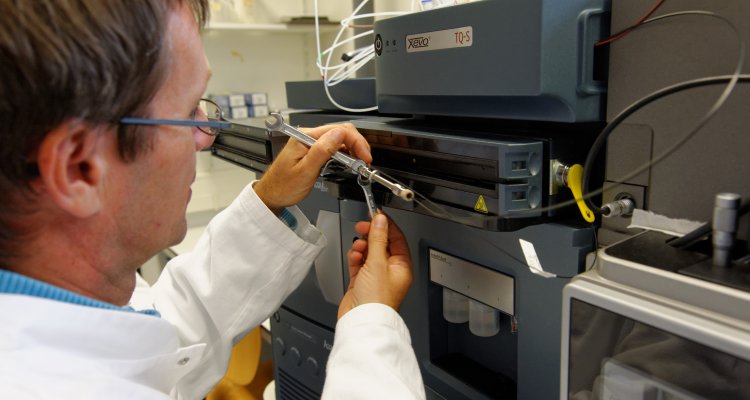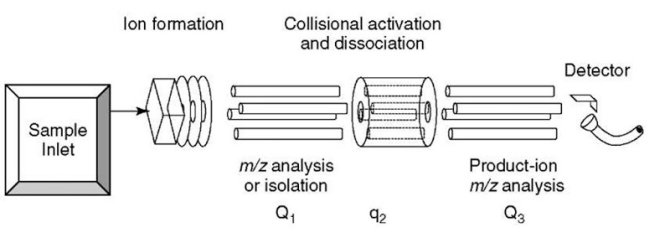
Equipment
UPLC-triple quad mass spectrometer; for targeted quantitative LC-MS detection
This highly sensitive LC-MS system is optimally equipped for fast, sensitive and selective quantitation of a diverse range of biological molecules within a complex extract. The versatility of the system enables the detec¬tion of small molecules such as metabolites, hormones, toxins, pesticides or larger molecules such as peptides (from peptidomics or proteomics samples). For these different molecules dedicated detection methods are available or can be custom-developed.
The high performance I-class Acquity UPLC provides exceptional reproducibility in fast liquid chromatographic separation up-front of the MS detector. The Xevo TQ-S triple quad MS system, with its StepWave technology, delivers enhanced precursor ion collection for maximal sensitivity an robustness. ScanWave technology allows ions within the collision cell to be accumulated and separated according to their mass-to-charge ratio (m/z). Synchronizing these ions with the scanning of the second quadrupole significantly enhances product ion spectra, enabling you to more easily confirm the identities and structures of your analytes of interest. ScanWave-enhanced product ion scans are triggered from the detection of a target analyte in MRM mode.
Specifically for proteomics applications there is also the option to connect a nanoLC system for utmost sensitivity in the sub-femtomol detection range. The combination with proteomics untargeted analysis provides integrated services for marker discovery, and subsequent fast development of optimised targeted quantitative detection methods. Several tenfold of targets can be quantified in parallel during a single analysis.
Principle
Triple quad MS technology is a well-established technology for sensitive targeted detection of small molecules in complex background samples. The specificity of a triple-quad mass spectrometer is based on the subsequent selection of a precursor molecule in the first quadrupole followed by fragmentation in the second quadrupole (collision cell) and, finally, selection of a specific fragment ion derived from the precursor in the third quadrupole. This staged selection enables sensitive and selective detection of molecules in a very complex background. The selected fragment ion is detected by an ion detector optimised for high sensitivity and a broad dynamic range, enabling accurate and linear quantitation in a broad range of concentrations.

Proteomics techniques for ion dissociation fragmentation and scanning in msms-proteomics
Technical details
Waters Acquity I-class UPLC system:
- Flow range .050 to 2 ml/min
- Injection volume 1-10 μl
- Precision column thermostat with active buffer pre-heating
- Excellent reproducibility in retention times
Waters Xevo TQ-S
- Maximum sensitivity, down to sub-femtomol injected amount
- Linear dynamic range 3 to 4 orders magnitude
- StepWave for enhanced sensitivity and less contamination
- ScanWave for optimal timing of fragment ion detection
- Dynamically triggered MS/MS scan for precursor confirmation
- IntelliStart for automated method development
- General mass range 50 – 4,000 Da
Shared Research Facilities also offers
- Waters Quattro Premier XE (including sample tower)
- AB Sciex QTRAP 5500
- AB Sciex QTRAP 6500 (with SelexION for effective ion mobility spectrometry)
Applications
Accurate and sensitive detection and quantitation of a diverse range of small biomolecules, such as:
- Metabolites
- Hormones
- Toxins, elicitors
- Drugs, pesticides
- Peptides
Specific expertise is provided for:
- Development of targeted methods for protein quantitation based on proteomics marker analyses
- Targeted detection of plant hormones
- Hormones in animal matrices, feed and forensic samples
- Veterinary drugs in animal matrices and feed
- Pesticides in vegetables and fruit
- Toxins in vegetables, fruit and cereals
- Marine toxins in fish and shellfish
Applications in other research fields:
- Pharmacokinetics
- Toxicology screening and confirmation
- Contaminants
- Forensics